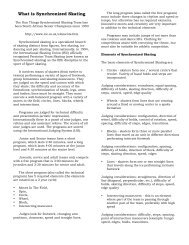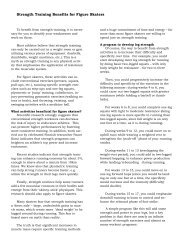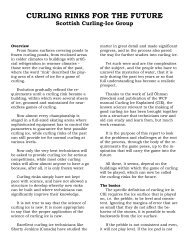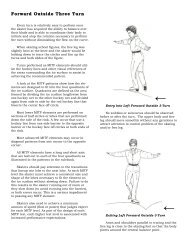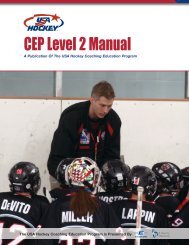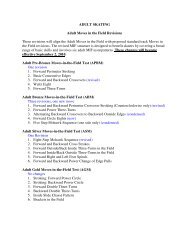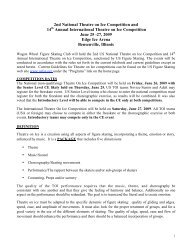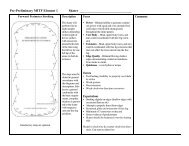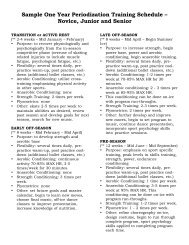CEP Level 3 Manual - Rushmore Hockey Association
CEP Level 3 Manual - Rushmore Hockey Association
CEP Level 3 Manual - Rushmore Hockey Association
You also want an ePaper? Increase the reach of your titles
YUMPU automatically turns print PDFs into web optimized ePapers that Google loves.
T A B L E O F C O N T E N T Sorganized just a little, you can achieve greaterresults.A basic (or least complex) offensive pattern is“everybody play his position”. This is the firstoffensive concept that should be taught. In simpleterms - spread out! The wingers skate up and downhis/her respective side of the rink. This createsterritorial division of the ice surface. If your playersmaintain these lanes or areas and do one more thing- pass the puck to the open man - you will have areasonably acceptable offensive system. Figure 1illustrates the areas of play appropriate for forwardsand defensemen.ForwardsDefensemenAREALEFT DEFENSEAREAR DEFENSEAREARIGHT DEFENSEAREALEFT WINGAREACENTER AREAL WINGAREARIGHT WINGC AREA AREAR WINGAREAOFFENSE IN YOUR DEFENSIVE ZONEOffensive play in the defensive zone iscommonly referred to as the breakout play and isconsidered to be one of the most importantaspects of the game. The success or failure of thebreakout will determine whether the team playsoffense or is forced to return to defense. Theobjective of the breakout play is to clear theoffensive zone while maintaining possession of thepuck.The success of your team’s breakout play isdependent upon teamwork. It is very difficult forone player to clear the zone by himself/herself.Consistently effective breakouts must be executedquickly with all the players working together as aunit.There are several different systems that may beutilized to clear the defensive zone. For starters,have your players master a basic, yet balancedsystem which allows for the breakout play to bemade to either wing or up the middle.We will start by assuming recovery of the puckby a defenseman. As illustrated in Figure 1a, thewings go quickly to their breakout positions alongthe boards, inside the hash marks on the face-offcircle (never turning their backs to the puck). Thecenter starts in the middle by moving away from thepuck side (or strong side) and then skates across (orcurls) toward the puck side. The defenseman thenhas the options illustrated in Figure 1 a-d open tohim:D1D2In option 1 (Figure 1a), W1, after receiving theinitial pass, can; (a) pass to C, (b) carry the puck, (3)return a back pass to D1.Passing from W1 to W2 or W1 to D2 is usuallyrisky and therefore should be avoided.D1Figure 1b. Breakout pass to the centerCW1D1W1CFigure 1c. Defensemen carry the puck up the iceD2W2W2D1 needs to “call” D2 to arrange this option. D2then has the same options as indicated in a, b, andc above. D1 can also move behind the net and setup the same options on the opposite side.NOTES: Offensive in the Defensive Zone• This breakout system has one forward that isalways in position to move quickly todefense, should control of the puck be lost• The system emphasizes high percentagepasses (short, direct, and quick)• The defenseman “quarterbacks” the play• All three forwards are utilized, althoughspecific roles may changeOFFENSE IN THE NEUTRAL ZONEThe middle (or neutral) zone is not often usedfor offensive play. It is jammed between “Thankgoodness we got it out of our zone” and “How canI get free in front of the net?”The primary objective of neutral zone offenseis to set up the attack and enter the offensive zonewith possession of the puck. You should teachsimple guidelines which give a sense of direction tothe offensive unit while at the same time allowingyour players to be creative and innovative. The mostimportant offensive guideline you can teach yourplayers is to create a two-on-one situation. Themiddle zone is the place to initiate strategy. In thiszone, players need to learn how to “read” which sidelacks backchecking. As this is determined, theyshould then move to attack the defenseman on thatside and move him away from his defensive alley. Toinitiate this situation, teach your puck carrier to enterthe offensive zone near the boards (See Figure 2).W1CW2D1D2Figure 1. Areas of play in position offenseW1W2CFigure 1a. Breakout pass to the wingFigure 1d. Breakout pass to the other defensemen176 | USA <strong>Hockey</strong> Coaching Education Program <strong>Level</strong> 3 <strong>Manual</strong>Offensive Team Tactics | 177



